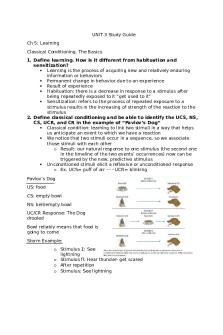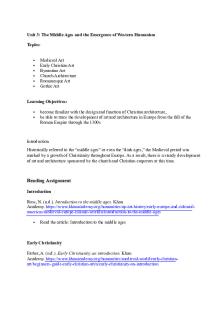ESSC 101 Study Guide for Unit 3 Exam PDF

| Title | ESSC 101 Study Guide for Unit 3 Exam |
|---|---|
| Course | Earth And Space Science I |
| Institution | Southeastern Louisiana University |
| Pages | 2 |
| File Size | 80.3 KB |
| File Type | |
| Total Downloads | 92 |
| Total Views | 136 |
Summary
essc short answer questions study guides...
Description
ESSC 101 Study Guide for Unit 3 Exam These questions are designed to get you to think about the major concepts in class and most importantly to put these concepts in your own words. This will not be helpful as a study guide if you copy and paste sections of the notes into the document. One of these questions will be the essay question on the exam, so it is absolutely worth your time to answer the following questions carefully and review the answers thoroughly. Answers to the essay question copied verbatim from the lecture notes will receive an immediate 0. 1. Why does the ocean circulate and what factors influence its circulation? ● The water in the ocean circulates because it’s a constant motion of warm water moving to a denser colder temperature back to a less dense warmer temperature. The factors that influence circulation in the ocean are the temperature of the region that the water is in and also the air movement. The air does virtually the same thing as the water where the colder air will move to the warmer region and the warmer air will move to the colder region. The movement of the air is helping to push the water in the ocean into circulation. 2. What is the difference between an active and passive continental margin and what type of coastline would you expect to find at each? ● Passive continental margins are wide with no deep trenches. A much wider boundary and much more sediment coming into the system. With the active continental margin, you have a narrower boundary and barely any sediment flowing into the system. The biggest difference is that the active has a deep oceanic trench and the passive does not. With the Active coastline you would have a very flat and long coastline that would eventually drop straight down very far. With the passive coastline you could have a very general sloping coastline going down leading to an abyssal plain. 3. What are the three main controls on the shape and sediment distribution of a coastline? How do each of these processes influence the shape of coastlines worldwide. ● The three main controls on the shape and sediment distribution of a coastline are sources of sediment, tides, and waves. Sources of sediment influences the shape of coastlines by bringing in sediment into the system for the tides and waves to carry it. Major sources of sediment include sediment from rivers surrounding the area and for regions without many rivers, sediment comes from erosion of surrounding rock and land. The waves are going to carry the sediment farther into the ocean to build up the oceanic ground and the tide is going to build up the shoreline by pushing the sediment into the coastline. 4. How do meandering streams or rivers change and evolve over time? Why do we consider the Mississippi River to be a mature meandering river? ● Rivers that carry fine grained silt and clay are the ones that are meandering over time. On one side of the river you have the deposition and the other you have the erosion which causes the river to progressively start to curve. The wider the curves become you start to develop point bars on the insides of the curves which is built up sediment that was deposited there. On the other side of the curves is where erosion takes place which builds up a bigger curve. Whenever the curve
gets so wide that the meander neck is almost touching when they eventually cut off back into a straight river and leaves a oxbow lake to the outside of the river. Though the Mississippi river still has bends and curves it has already straightened out a lot and already cut through all those meander necks and created many oxbow lakes. For this the Mississippi river is considered mature. 5. How does oil and natural gas form and how is it stored underground? Why do the same factors that make a good aquifer also make a good reservoir rock? ● Oil and natural gas forms from many years of dead plankton that fell to the bottom of the ocean being crushed by many years of built up clay and rock producing great pressure. Then it is buried even deeper than that into the ocean by what is called the source rock into the oil window where the temperature and pressure are high enough to change the substances. The rocks that are used to make good reservoirs are medium finely grained rocks that are highly permeable which means it can be stored to oil and natural gases and can also push them up higher. Which is also what makes up a good aquifer where water flows through and is stored in. 6. What are the possible sources of salinity in freshwater aquifers and how can you determine which source is likely? ● The salinity in freshwater aquifers is ultimately broken down into two different categories: Marine sources and non-Marine sources. Your marine sources are pretty much anything having to do with the surrounding areas of major water carrying contaminants into the aquifer. Your nonMarine sources are human made pollution that we put in the water and also the breakdown of salt domes flowing into the aquifers. To determine which source the salinity is coming from you could look at the surrounding salt domes and how deep they are underground, and you could look at how much freshwater is around the aquifer because surrounding freshwater sometimes pushes salinity higher up toward the surface. To figure out if it is coming from a surrounding major water area, you could look to see where the salinity has started first and see if it is in the general area of the major body of water. 7. Why do ice ages exist and what are the effects of past glaciations? ● Ice Ages are described as glacial cycles during Earth's timeline. They exist because of very little changes in the Earth's properties. The changes in the Earth's axial tilts and the changes in the Earth’s orbit can cause us to dip into Ice Ages. The changes are very slight but can evidently cause a lot of changes on Earth. This is described as shifting in and out of Interglacial periods and Glacial periods. Some direct effects of past glaciations are that many of the land basins that we know of today were carved out of ice sheets moving across the ground, also many rivers were carved out of moving ice like the ones in Minnesota and New York. Some indirect effects of past glaciation are the rises and declines of sea levels. When much of the water freezes up and becomes ice sheets then the water level lowers by multiple meters but if all the ice caps on Earth were to melt today then much of the coastlines would be under water....
Similar Free PDFs

Anthro 101 Unit 1 exam Study Guide
- 20 Pages

ERTH 101 Study Guide for Exam 2
- 19 Pages

ECON 101 EXAM 3 Study Guide
- 17 Pages

Study guide for exam 3
- 22 Pages

UNIT 3 Study Guide
- 19 Pages

Unit 3 Study Guide
- 4 Pages

Biodiversity Unit 3 Exam Study Guide
- 18 Pages

Unit 2 Exam Study Guide Micro -3
- 17 Pages

Unit 3 study guide - unit test 3
- 3 Pages

Exam 3 - Study Guide
- 31 Pages

EXAM 3 study guide
- 2 Pages

Exam 3 Study Guide
- 8 Pages

Exam 3 study guide
- 9 Pages

Exam 3 Study Guide.
- 14 Pages
Popular Institutions
- Tinajero National High School - Annex
- Politeknik Caltex Riau
- Yokohama City University
- SGT University
- University of Al-Qadisiyah
- Divine Word College of Vigan
- Techniek College Rotterdam
- Universidade de Santiago
- Universiti Teknologi MARA Cawangan Johor Kampus Pasir Gudang
- Poltekkes Kemenkes Yogyakarta
- Baguio City National High School
- Colegio san marcos
- preparatoria uno
- Centro de Bachillerato Tecnológico Industrial y de Servicios No. 107
- Dalian Maritime University
- Quang Trung Secondary School
- Colegio Tecnológico en Informática
- Corporación Regional de Educación Superior
- Grupo CEDVA
- Dar Al Uloom University
- Centro de Estudios Preuniversitarios de la Universidad Nacional de Ingeniería
- 上智大学
- Aakash International School, Nuna Majara
- San Felipe Neri Catholic School
- Kang Chiao International School - New Taipei City
- Misamis Occidental National High School
- Institución Educativa Escuela Normal Juan Ladrilleros
- Kolehiyo ng Pantukan
- Batanes State College
- Instituto Continental
- Sekolah Menengah Kejuruan Kesehatan Kaltara (Tarakan)
- Colegio de La Inmaculada Concepcion - Cebu

